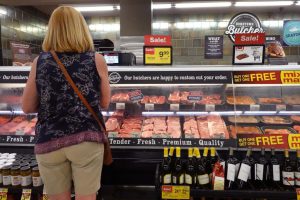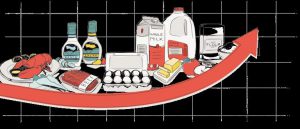NOVEMBER 13, 2021

With inflation at a 31-year high, Americans are feeling the pinch in just about every facet of daily life.
There’s been plenty of finger-pointing from both sides of the political aisle about who’s responsible for the spiraling costs, but as usual with issues that have such a broad impact, the causes are complex.
President Joe Biden acknowledged Wednesday that “inflation hurts Americans’ pocketbooks, and reversing this trend is a top priority for me.’’ But he said his $1 trillion infrastructure package, including spending on roads, bridges and ports, would help ease supply bottlenecks.
Here’s a quick breakdown of how we got here and some of the strategies that might help reverse the trend:
Why are grocery prices so high?
There are myriad reasons for the higher grocery bills, including the same labor shortages, supply chain bottlenecks and strong consumer demand that have driven up the cost of other goods and services. Toss in the wild cards plaguing the food industry: Extreme weather, particularly heat and drought that have curtailed crop yields. A surge in exports. COVID-19 outbreaks at meatpacking plants. Volatile consumer eating patterns amid the ups and downs of the health crisis.
Meanwhile, dire worker shortages, particularly at restaurants, have pushed up wages and the cost of dining out.
There are still fewer factory, warehouse and port workers as parents care for distance-learning children or stay home because of COVID-19 fears. Fuel costs have soared. Dozens of container ships are stuck in the waters near the Ports of Los Angeles and Long Beach, California, waiting to unload cargo. The cost to lease a shipping container for a delivery from China has increased nearly tenfold to $20,000.

There are myriad reasons for the higher grocery bills. – Jennifer Borresen
Other factors driving inflation
Cars are one of the leading culprits.
Also behind the spike are items such as hotel rates and airline fares, which plunged last year in the early days of the pandemic and rose sharply from those lows this year as consumer demand returned amid the reopening economy.
Supply chain bottlenecks, with COVID-19-related worker absences at factories and ports still high, are also leading to low supplies and higher prices for consumer electronics, appliances and many other products.
The crunch comes on top of a semiconductor shortage and parts supply disruptions that have meant low inventories and higher prices for cars.
The average sales price of a new vehicle hit a record $42,802 in September, breaking the old record of $41,528 set in August, J.D. Power said. The average U.S. price is up nearly 19% from a year ago, when it broke $36,000 for the first time, J.D. Power said. The auto price increases have helped to drive up U.S. inflation.
What role did the stimulus play in driving inflation?
That’s complicated. The stimulus checks, which started to get mailed out under President Donald Trump’s administration, continued through March, when eligible married couples, for example, received up to $2,800 – plus $1,400 for each dependent.
The economy looked very different in the spring of 2020, when Americans first started to receive stimulus checks: The U.S. economy had collapsed as lockdowns took effect, businesses closed or cut hours and consumers stayed home as a health precaution. Employers slashed 22 million jobs. Economic output plunged at a record-shattering 31% annual rate in last year’s April-June quarter.
Everyone braced for more misery. Companies cut investment. Restocking was put off. And a brutal recession ensued.
Yet instead of sinking into a prolonged downturn, the economy staged an unexpectedly rousing recovery, fueled by massive government spending and a bevy of emergency moves by the Fed. By the spring of 2021, the rollout of vaccines had emboldened consumers to return to restaurants, bars and shops.
Suddenly, businesses had to scramble to meet demand. They couldn’t hire fast enough to plug job openings – a near record 10.4 million in August – or buy enough supplies to fill customer orders. As business roared back, ports and freight yards couldn’t handle the traffic. Global supply chains became snarled.
Costs rose. And companies found that they could pass along those higher costs in the form of higher prices to consumers, many of whom had managed to sock away a ton of savings during the pandemic.
To curb inflation, fed reduces bond purchases
Last month, in a milestone for the U.S. recovery from the COVID-19 recession, the Federal Reserve agreed to gradually dial back the bond-buying stimulus it launched early in the health crisis.
The decision, which has been expected for months, reflects the strides the economy has made, with unemployment falling sharply from its pandemic peak. But it also pointedly reveals the central bank’s growing concern about inflation that has surged in recent months amid supply chain bottlenecks.
Fed Chair Jerome Powell told reporters the Fed will be patient and hold off on raising rates so the economy can reach full employment, but he added officials “won’t hesitate” to act if inflation doesn’t ease, presumably by the second half of next year.
Biden announces ports open 24/7 to fight inflation, reduce supply chain crunch
In October, Biden announced that the Port of Los Angeles – at the center of the supply chain logjam – will operate around the clock to help clear out some of the hundreds of thousands of shipping containers from Asia stranded on its docks. The neighboring Port of Long Beach, which has been conducting a similar pilot project at one of its 12 terminals, is expected to follow.
As ports gear up operations, dozens of cargo vessels dot the surrounding harbor, waiting for the chance to unload 40-foot containers filled with food, clothing and even holiday gifts, from skateboards to elliptical bicycles. In normal times, there are no waits.
But it’s not that simple.
A visit to the ports of Los Angeles and Long Beach and interviews with port officials, union representatives, workers and freight companies reveal it likely will take months to make a significant dent in the port backlog and disentangle the myriad other kinks in the nation’s vast supply network.
Other players, including truck drivers and warehouse workers, need to shift their schedules. There are also equipment shortfalls, bureaucratic hurdles and severe worker shortages at other hubs in the overwhelmed supply chain.

































































































